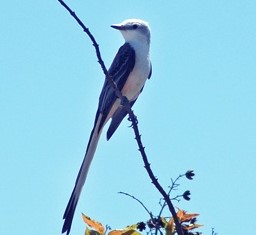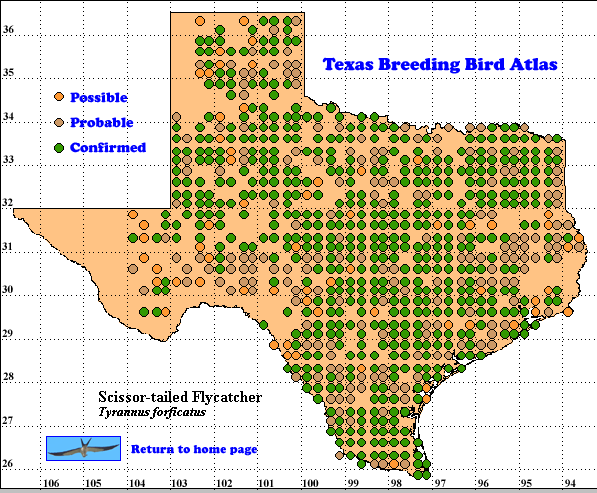The striking and graceful Scissor-tailed Flycatchers are common summer residents in most of Texas as these birds forage from isolated trees, often mesquites, flying forth to snatch grasshoppers or beetles from the air. Trailing their long tails, they may also drop to the ground to capture these insects (Regosin 1998).
This flycatcher and the Fork-tailed Flycatcher (T. savana), a casual visitor to Texas from Mexico (Am. Ornithol. Union 1998, Lockwood and Freeman 2004) are the only members of their genus with elongated tail feathers. Since both sexes have long tails (the male tails are generally longer) tail length does not appear to be associated with sexual attraction. The purpose of these long feathers is not clear since other members of the genus, including 7 species in North America, have similar life histories and lack these elegant long tails (Regosin 1998).
DISTRIBUTION. During the 1987-1992 field work seasons of the TBBA project, atlasers found breeding evidence for Scissor-tailed Flycatchers throughout all regions of the state except the western Trans-Pecos and the western edge of the Panhandle. The TBBA map shows a similar distribution pattern to that derived from North American Breeding Bird Survey (BBS) data which indicates the highest relative abundances in Texas and the United States are in the South Texas Brush Country, Coastal Sand Plain and in the northern part of the Rolling Plains south of the Red River. Here relative abundances are in the 30-100 flycatchers per route range (Sauer et al. 2007). The three highest route averages in the United States came from Callahan, Brooks and Shackelford counties with averages of 113, 100 and 53, respectively (Price et al. 1995).
From Texas the breeding range of this flycatcher extends south into extreme northeast Mexico and north though Oklahoma, where the species is widespread everywhere except the western Panhandle (Dole 2004), into southeast Kansas with slight overlap into surrounding states. These birds winter in the lowlands of west and south Mexico and the Pacific slope of Central America (Howell and Webb 1995, Regosin 1998, Sauer et al. 2007).
SEASONAL OCCURRENCE. Scissor-tailed Flycatchers arrive in Texas from late February (south Texas) to late May and breed from late March to late August, based on egg collection dates from March 31 to August 10. Southbound movement starts as soon as early August and lasts until late October or early November. Some individuals overwinter in at least one location (Oberholser 1974, Lockwood and Freeman 2004).
BREEDING HABITAT. Scissor-tailed Flycatchers breed in Texas from near sea level to 1200 m (4000 ft) in semi-open country such as plains, prairies, farms, ranches and clearings (Oberholser 1974). In the Lower Rio Grande valley, these flycatchers are common nesters in both natural and suburban savanna habitats Brush 2008). In Oklahoma atlasers mentioned prairies and fields with scattered trees and shrubs, woodland edges, hedgerows and occasionally towns (Dole 2004). The few flycatchers breeding in extreme southeast Colorado nested at the edge of cottonwood groves (Potter 1998).
The nest, built by the female in as little as 2-4 days, is usually placed 2-9 m (7-30 ft) above ground on a horizontal tree limb or in a fork or crotch. These flycatchers also use man-made structures such as utility poles or bridge girders. The base and shell of the nest cup are roughly constructed of forb stems, twigs, rootlets, agricultural waste and human trash. This shell is finished and lined with finer materials. Although nest sizes vary, some typical dimensions are: outside diameter 11.4 -15 cm (4.5-6 in), height about 7.6 cm (3 in), inside diameter, 7-9 cm (2.8-3.5 in) and cup depth 4.5-5.7 cm (1.8-2.3 in; Harrison 1979, Regosin 1998).
In this somewhat oval nest (see photo in Harrison 1979), the female usually lays 4-5 (range 3-6) smooth, white or creamy white eggs with dark red or reddish brown spots or blotches. The eggs are indistinguishable from those of Eastern (T. tyrannus) and Western (T. verticalis) kingbirds. The female incubates the eggs for 13-16 days or longer in colder weather. The young leave the nest, capable of some flight, 14-17 days after hatching . Second successful broods are rare as is brood parasitism (Harrison 1979, Regosin 1998).
STATUS. Scissor-tailed Flycatchers are common to locally abundant summer residents in most of Texas (Lockwood and Freeman 2004). The map in Oberholser (1974) is quite similar to the TBBA map. BBS data from 102 routes in Texas on which this flycatcher was detected suggest a -0.3% annual population change for the period 1980-2006, similar to the -0.9% trend from 57 routes in Oklahoma and -0.4% from 323 routes in the United States (Sauer et al. 2007). This minor decline, essentially indistinguishable from zero is a good omen for the future of the Scissor-tailed Flycatcher’s future in Texas.
Text by Robert C. Tweit (2008)
Literature cited.
American Ornithologists’ Union. 1998. Checklist of North American birds, 7th ed. Am, Ornithol. Union, Washington, DC.
Brush, T. 2008. Use of natural and artificial savannas by birds in the lower Rio Grande valley of Texas. Bull. Texas Ornithol. Soc. 41: 13-18.
Dole, J. M. 2004. Scissor-tailed Flycatcher (Tyrannus forficatus). In Oklahoma breeding bird atlas, pp. 250-251 (D. L. Reinking, ed.). University of Oklahoma Press, Norman.
Harrison, H. H. 1979. A field guide to western birds’ nests. Houghton Mifflin, Boston, MA.
Howell, S. N. G. and S. Webb. 1995. A guide to the birds of Mexico and northern Central America. Oxford University Press, New York.
Lockwood, M. W. and B. Freeman. 2004. The TOS handbook of Texas birds. Texas A&M University Press, College Station.
Oberholser, H. C. 1974. The bird life of Texas. University of Texas Press, Austin.
Potter, K. M. 1998. Scissor-tailed Flycatcher (Tyrannus forficatus). In Colorado breeding bird atlas, pp. 298-299 (H. E. Kingery, ed.). Colorado Bird Atlas Partnership, Denver.
Price, J., S. Droege, and A. Price. 1995. The summer atlas of North American birds. Academic Press, New York.
Regosin, J. W. 1998. Scissor-tailed Flycatcher (Tyrannus forficatus). In The birds of North America, No. 342 (A. Poole and F. Gill, eds.). The Birds of North America, Inc., Philadelphia, PA.
Sauer, J. R., J. E. Hines, and J. Fallon. 2007. The North American breeding bird survey, results and analysis 1966-2006. Version 7.23.2007. USGS Patuxent Wildlife Research Center, Laurel MD < http://www.mbr-pwrc.usgs.gov/bbs>

